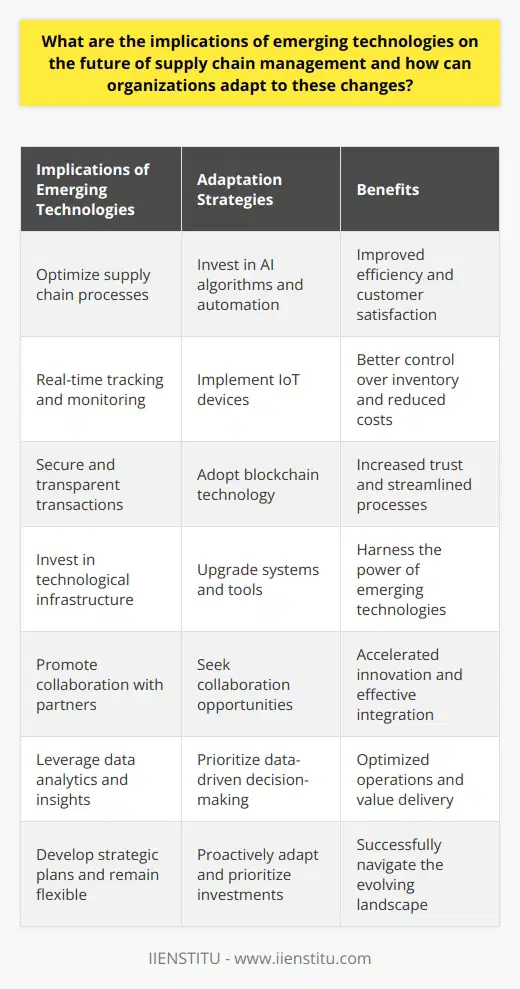
Overview of Supply Chain Analytics
Benefits of Supply Chain Analytics in Supply Chain Management
Challenges of Implementing Supply Chain Analytics
Impact of Supply Chain Analytics on Business Performance
Future Prospects for Supply Chain Analytics
Supply chain analytics is analyzing and leveraging data to improve supply chain performance. It offers significant benefits to businesses that can effectively implement it. It can help reduce costs, improve customer satisfaction, and increase profitability. However, the implementation of supply chain analytics can also present challenges. This article will explore supply chain analytics'sanalytics' benefits, challenges, and future.
Overview of Supply Chain Analytics
Supply chain analytics is the process of using data to analyze and improve the performance of supply chain operations. The goal of supply chain analytics is to identify inefficiencies and opportunities for improvement in areas such as cost, customer satisfaction, and inventory management. It is also used to predict customer demand and optimize the supply chain accordingly. Companies use various tools such as machine learning, artificial intelligence, and predictive analytics to analyze data and make decisions.
Benefits of Supply Chain Analytics in Supply Chain Management
The use of supply chain analytics offers many benefits to businesses. First, it can help reduce costs by identifying and eliminating inefficiencies in the supply chain. This can include reducing inventory levels and streamlining distribution networks. It can also help improve customer satisfaction by predicting customer demand and delivering products faster. Finally, it can increase profitability by optimizing inventory and supply chain operations.
Challenges of Implementing Supply Chain Analytics
Although supply chain analytics offers many benefits, its implementation also has associated challenges. One of the significant challenges is the availability of data. Companies must collect and analyze large amounts of data to effectively use supply chain analytics. Additionally, the data must be highly qualified for the analytics to be accurate and reliable. Finally, companies must also have a robust IT infrastructure to utilize the data effectively.
Impact of Supply Chain Analytics on Business Performance
The use of supply chain analytics can have a significant impact on a company's-company's business performance. Companies that effectively implement and utilize supply chain analytics can reduce costs, improve customer satisfaction, and increase profits. This can lead to an increase in market share and competitive advantage. Additionally, companies using supply chain analytics to effectively predict customer demand can reduce inventory costs and increase the supply chain's efficiency.
Future Prospects for Supply Chain Analytics
The future of supply chain analytics looks promising. Companies are increasingly turning to analytics to drive their supply chain operations. This trend will likely continue as technology advances and businesses become more data-driven. In addition, companies increasingly use predictive analytics to forecast customer demand and optimize their supply chains accordingly. This trend will likely continue as companies become more attuned to customer needs and preferences.
Overall, supply chain analytics offers many benefits to businesses that can effectively implement it. It can help reduce costs, improve customer satisfaction, and increase profitability. However, companies must be aware of the challenges associated with implementing supply chain analytics and take the necessary steps to address them. With the right approach, supply chain analytics can significantly impact a company's-company's performance. The future of supply chain analytics is promising, and companies should take advantage of its opportunities.
A well-managed supply chain is the foundation of a successful business.
The article provides an in-depth exploration of supply chain analytics, including its benefits, challenges, impact on business performance, and future prospects. By effectively implementing supply chain analytics, businesses can achieve substantial benefits such as reduced costs, improved customer satisfaction, and increased profitability. However, such an implementation presents challenges, such as data availability and the need for robust IT infrastructure. Despite these challenges, the future looks promising for supply chain analytics, with increasing technological advances and the rising importance of data-driven strategies. For those keen to incorporate these insights into their operations, supply chain courses online free offer further knowledge and skills development. A well-managed supply chain remains to be the cornerstone of a successful business.
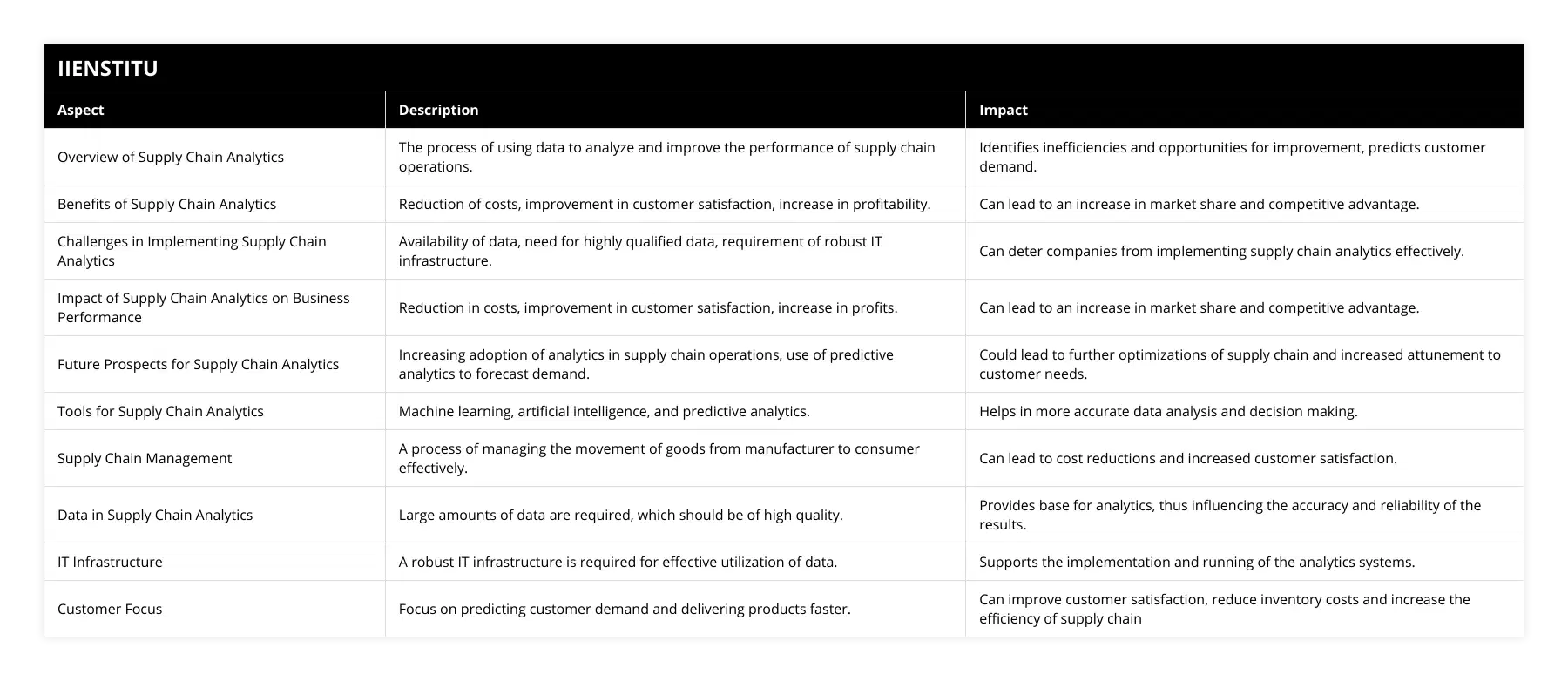
Frequently Asked Questions
What are the benefits of implementing supply chain analytics?
Implementing supply chain analytics is becoming increasingly critical for organizations seeking to stay competitive and responsive to customer needs in a rapidly changing global market. Supply chain analytics is the application of sophisticated statistical and data analysis techniques to evaluate and improve the performance of an organization's supply chain operations. This includes forecasting, inventory optimization, demand planning, logistics network design and optimization, supplier selection, pricing strategies, and more. Implementing such a system has numerous benefits, from cost savings through enhanced efficiency to improved customer satisfaction.
One benefit of using supply chain analytics is reduced costs due to improved efficiency. By analyzing data regarding orders, shipments, inventory levels, supplier contracts, freight costs, and more across the entire supply chain system, organizations can identify opportunities for cost savings that may be hidden when looking at individual components in isolation. Additionally, supply chain analytics can help organizations make better-informed decisions about managing their resources; this can help reduce waste resulting from overstocking or understocking products or services.
Another benefit of implementing supply chain analytics is improved customer satisfaction due to faster delivery times. By analyzing data from across the entire supply chain network, it is possible to identify bottlenecks that are delaying product deliveries or causing shipment delays in specific areas; this information can then be used to optimize transportation routes or adjust production schedules accordingly so that customers receive orders faster than before. In addition, better visibility into inventory levels lets companies keep their customers informed about when orders will arrive—ensuring that they are not left waiting unnecessarily long periods for their purchases.
Finally, supply chain analytics also enables organizations to gain valuable insights into market trends that can be used to develop effective pricing strategies or adjust product offerings as necessary to meet changing customer needs, or capitalize on new opportunities within the marketplace before competitors do so first. This helps ensure that companies remain competitive while still delivering high-quality products at reasonable prices, ultimately leading to higher profitability over time, improving customer loyalty with existing clients, and gaining new ones along the way.
In summary, there are numerous benefits associated with utilizing a comprehensive system for analyzing data throughout an organization's entire supply chain network, including cost savings through increased efficiency, improved customer satisfaction due to delivered goods arriving faster than anticipated, and better insights into market trends enabling companies to develop effective pricing strategies for staying ahead of competitors within the marketplace going forward all leading towards greater profitability in both short-term as well as long-term contexts.
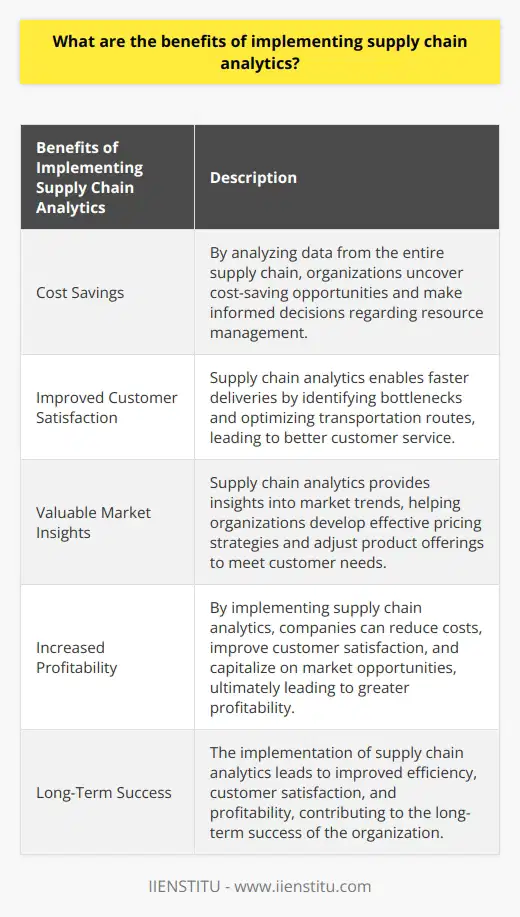
What challenges might arise when implementing supply chain analytics?
Supply chain analytics is a powerful tool for businesses to gain insights and optimize their operations. However, several challenges can arise when implementing supply chain analytics.
One of the main challenges is the integration of data. Supply chain data is often stored in various systems and formats, which can be difficult to consolidate and analyze. Additionally, data may be siloed in individual departments, making it difficult to obtain an accurate and comprehensive view of the supply chain. This can lead to inefficient use of resources, suboptimal decisions, and increased risk.
Another challenge is the accuracy of data. Data quality can lead to accurate insights and conclusions, resulting in misguided decisions. Data accuracy is essential for predictive analytics, which relies on accurate data for reliable predictions. Organizations must ensure that their data is accurate and up-to-date to get the most out of their analytics efforts.
A third challenge is the implementation of analytics. Once the data is collected and consolidated, it must inform decisions and actions. This cannot be easy, as it requires organizational buy-in and a clear understanding of how the analytics will be used. Additionally, organizations must ensure they have the right resources to implement analytics effectively.
Finally, organizations must consider the cost of implementing supply chain analytics. While the long-term benefits of analytics are significant, the upfront costs can be prohibitive for some organizations. Therefore, organizations must consider their budget and determine if the cost of implementing analytics is justified.
In conclusion, several challenges may arise when implementing supply chain analytics. These include data integration and accuracy, implementation of analytics, and cost. Organizations must be aware of these challenges and take steps to address them to ensure that their analytics efforts are successful.
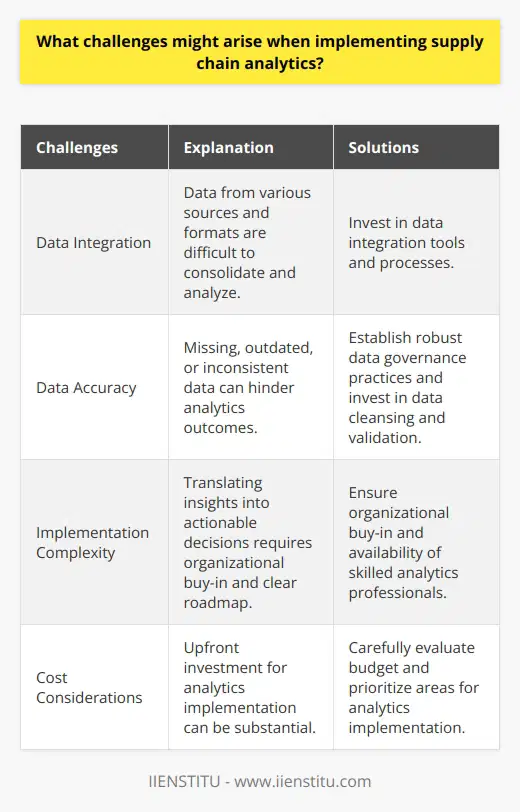
What trends can we expect to see in the future of supply chain analytics?
As the business world continues to become increasingly data-driven, organizations across various industries are turning to supply chain analytics to gain an edge over their competitors. Supply chain analytics provides valuable insight into how an organization’s supply chain is performing and can help identify potential areas for improvement, cost savings, and increased efficiency. In the coming years, we can expect to see several key trends in the future of supply chain analytics that will shape how organizations approach these types of analyses.
One trend already evident is the increased reliance on artificial intelligence (AI) and machine learning (ML). AI and ML will allow organizations to quickly identify patterns and anomalies in their supply chains that manual analysis may have overlooked. This increased level of detail will be invaluable for identifying weak points in the system, making process improvements, and streamlining operations. Additionally, AI-driven automation will reduce time wasted on manual processes and provide more accurate results than traditional methods.
Another trend that we can expect is an increase in predictive analytics tools. Predictive analytics allows organizations to forecast future events based on historical data or current conditions. For example, these tools could be used to predict customer demand or anticipate changes in market conditions, giving organizations a competitive advantage by allowing them to anticipate future needs before they occur. In addition, predictive analytics can be used for resource planning purposes, such as ensuring enough resources are available when needed or predicting shortages before they occur so more resources can be obtained in advance.
Finally, as technology continues to evolve rapidly, we will likely see more cloud-based solutions being utilized for supply chain analytics. Cloud computing offers numerous advantages over traditional methods, including greater scalability and cost savings due to its pay-as-you-go pricing model and its ability to provide real-time data insights from any location worldwide with an internet connection.
In conclusion, with new technological advancements continuing to emerge at an ever-increasing rate, likely, these three trends – the increased use of AI/ML capabilities, predictive analytic tools, and cloud computing solutions – will continue driving the future of supply chain analytics forward into uncharted territory with exciting possibilities ahead for those who embrace them properly.
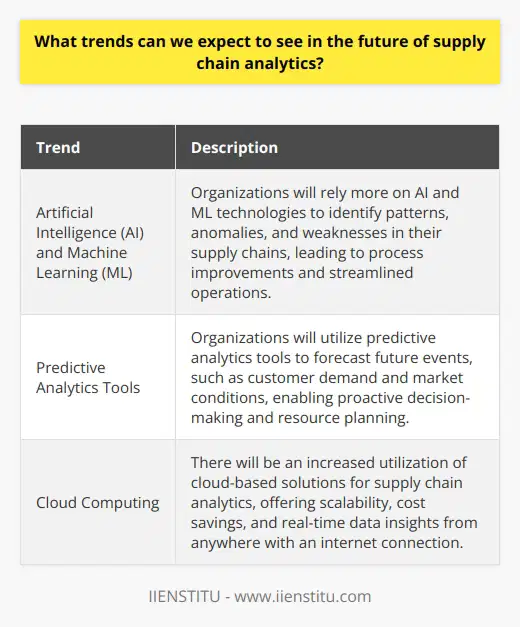
What are the key steps in conducting an effective supply chain analysis?
Identify the Scope
The first step in conducting an effective supply chain analysis is to identify the scope of the analysis. This involves determining which elements of the supply chain need to be examined and the specific objectives of the analysis. Clear goals must be set to guide the research process and ensure a focused approach.
Data Collection and Categorization
Following the scope identification, data collection becomes essential. This involves gathering quantitative and qualitative information on supply chain performance, such as cost, lead times, and quality. This data can be obtained from various sources, including internal records, customer/supplier feedback, and industry benchmarks. Once collected, categorizing the data appropriately helps in organization and a more comprehensive analysis.
Evaluating Performance Metrics
After collecting and organizing data, evaluating performance metrics becomes crucial. These metrics provide insight into the efficiency and effectiveness of a supply chain. Common performance indicators include on-time delivery, order fill rates, and inventory turnover. Comparing these metrics to industry standards or company goals allows for a better understanding of the supply chain's overall performance.
Identifying Bottlenecks and Opportunities
The next step in the process is to identify bottlenecks or constraints limiting supply chain efficiency. This often involves examining areas with the highest costs, longest lead times, or lowest quality performance. Identifying these bottlenecks helps to pinpoint areas where improvement efforts should be focused. Additionally, recognizing untapped opportunities can lead to further gains in efficiency and effectiveness.
Developing an Action Plan
Once bottlenecks and opportunities have been identified, developing a targeted action plan can help optimize the supply chain. The plan should outline specific strategies for addressing identified issues, such as reducing lead times or improving supplier relationships. Moreover, the plan should include timelines, metrics, and measurable objectives to assess progress and success.
Implementation and Continuous Improvement
Lastly, implementing the action plan and monitoring the results is the final step in supply chain analysis. Regular progress checks should be performed to track improvements and adapt strategies when necessary. Embracing a continuous improvement mindset ensures that the supply chain remains flexible and efficient in an ever-evolving business environment.
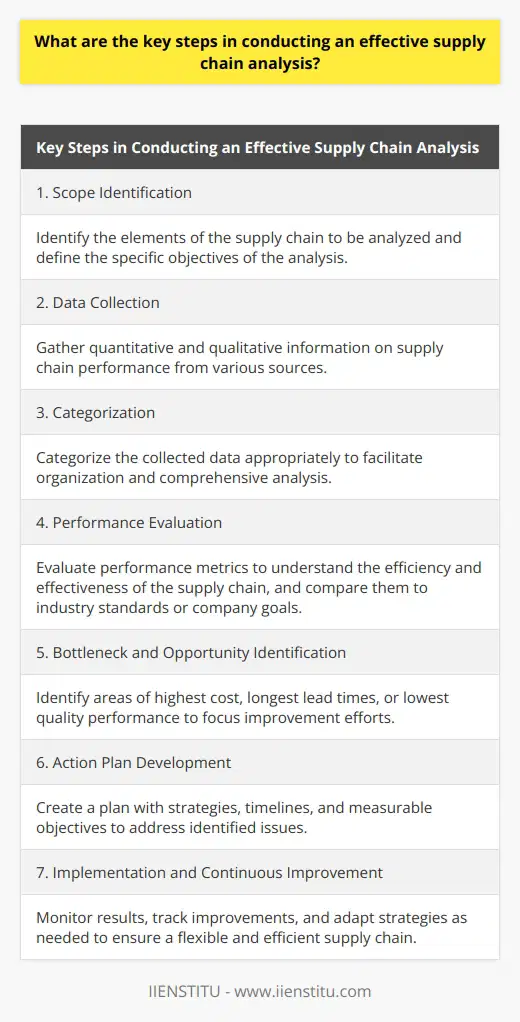
How can organizations mitigate the various risks associated with supply chain management?
Risk Identification and Assessment
Organizations can begin by identifying and assessing potential risks within their supply chain through systematic analysis, process mapping, and communication with key stakeholders. Risk identification allows organizations to proactively address supply chain disruptions, delays, and failures.
Supplier Diversification Appraisal
In order to mitigate the risks associated with supply chain management, organizations should evaluate the diversification of their suppliers. By sourcing critical components or services from multiple suppliers, businesses can better navigate disruptions and minimize the impact of potential risks on their operations.
Contract Management Strategies
Establishing formal risk management clauses and contracts with suppliers to clearly define expectations, responsibilities, and liabilities will further help in reducing supply chain related risks. These contracts may include provisions for alternative sourcing options, penalties for non-compliance, and agreed-upon performance metrics to ensure consistent quality and service.
Collaboration and Information Sharing
Fostering open communication and collaboration among various partners in the supply chain, such as suppliers, manufacturers, and retailers, allows for greater transparency and more efficient response to potential risks. Information sharing among stakeholders can help organizations quickly adapt to changes and promptly address any unforeseen issues in their supply chain.
Technological Integration and Data Analytics
Investing in advanced technology and data analytics tools can play a key role in reducing supply chain risks. These tools may include artificial intelligence, machine learning, or blockchain technology to monitor, predict, and control supply chain events. Furthermore, data analytics can help organizations identify patterns and trends that may highlight vulnerabilities and potential areas of improvement in their supply chain.
Contingency Planning and Business Continuity
Organizations should develop contingency plans and business continuity strategies for their supply chain to ensure smooth operation during unexpected events. These plans may include identification of alternative suppliers, distribution channels, or transportation options, as well as training and preparation of employees for emergency response.
In conclusion, organizations can mitigate various risks associated with supply chain management by implementing a comprehensive risk management strategy that involves risk identification, supplier diversification, contract management, collaboration, technological integration, and contingency planning. By actively managing these strategies, businesses can safeguard their supply chains and ensure their overall operational resilience.
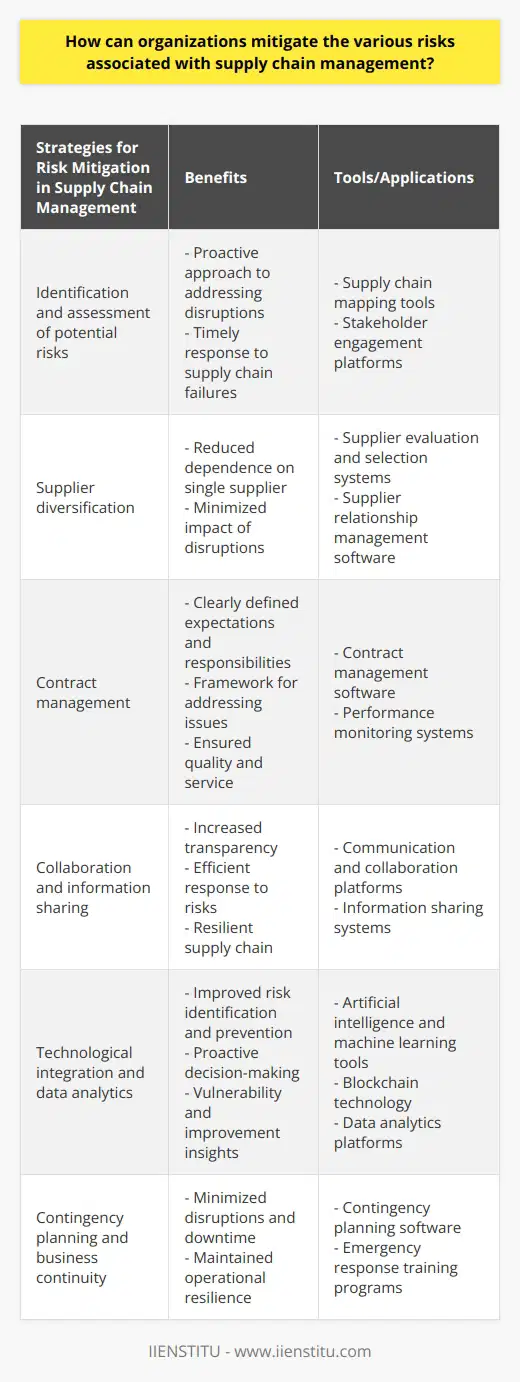
In what ways can supply chain analytics contribute to achieving sustainability goals in businesses?
Supply Chain Analytics for Sustainability Goals
One significant way supply chain analytics can contribute to achieving sustainability goals is through resource optimization. By collecting and analyzing data from various sources, businesses can identify inefficiencies and waste in their supply chain processes. This allows them to improve resource allocation, reduce waste, and minimize their carbon footprint.
Enhancing Transparency
Supply chain analytics also enhance transparency by providing businesses with accurate information on supplier practices and performance. This enables organizations to identify potential environmental, social, and ethical risks within their supply chain and promotes responsible sourcing. Furthermore, strong supplier relationships can be fostered by recognizing suppliers that uphold sustainable practices, ultimately contributing to the success of sustainability initiatives.
Prediction and Mitigation of Risks
In addition to enhancing transparency, supply chain analytics facilitate the prediction and mitigation of potential risks. By leveraging data and predictive analytics, businesses can anticipate disruptions or fluctuations in their supply chain, which may have detrimental effects on sustainability goals. By taking proactive measures to address these risks, businesses can maintain both operational stability and environmental accountability.
Encouraging Circular Economy
Another significant contribution of supply chain analytics to sustainability goals is the promotion of a circular economy. In a circular economy, materials are reused and repurposed, reducing the environmental impact associated with resource extraction and waste generation. With the aid of supply chain analytics, businesses can better understand the lifecycle of their products, thus identifying opportunities for circularity and promoting sustainable production and consumption patterns.
Driving Consumer Awareness and Engagement
Lastly, supply chain analytics can help businesses raise consumer awareness and engagement in sustainability initiatives. By leveraging data to communicate the environmental impact of products and suppliers, companies can effectively communicate their commitment to sustainability. This can result in improved brand reputation and increased consumer trust, ultimately driving the adoption of more sustainable consumption patterns.
In summary, supply chain analytics contribute to achieving sustainability goals by optimizing resources, enhancing transparency, predicting and mitigating risks, promoting a circular economy, and driving consumer awareness and engagement. By employing data-driven strategies, businesses can ensure that their supply chain processes are both environmentally responsible and economically viable.
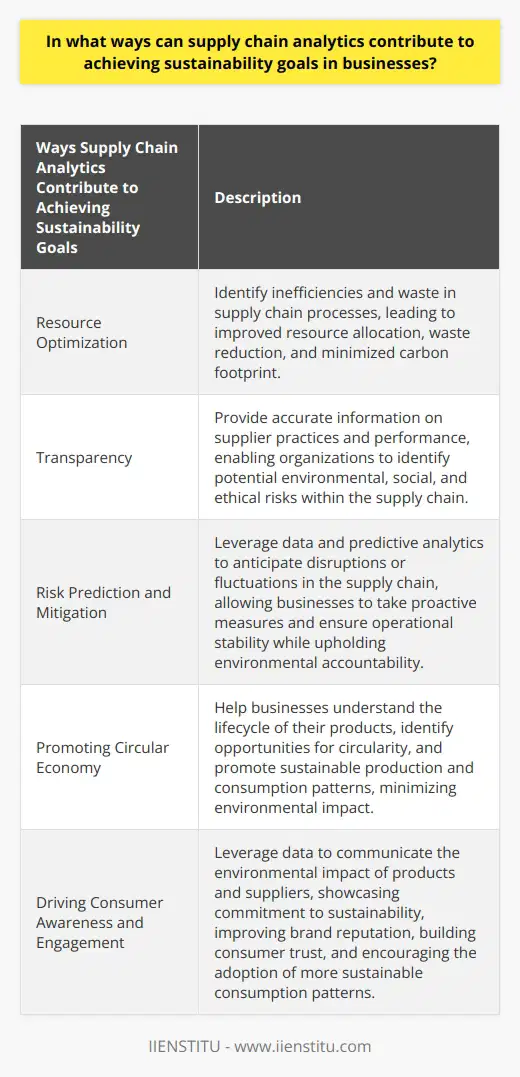
What are the future challenges of supply chain management, particularly in light of increasing globalization and technological advances?
Challenges in Global Supply Chain Management
One of the primary challenges in supply chain management (SCM) is adapting to the complexities of globalization. As firms expand their operations across borders, they must contend with diverse regulations, varying labor costs, and cultural differences. These factors can result in longer lead times, increased logistics costs, and difficulties in meeting customer demands. Moreover, organizations need to align their supply chain strategies with their global objectives, involving effective coordination and collaboration among suppliers, manufacturers, and distributors.
Impact of Technological Advances on SCM
Technological advances also pose significant challenges for SCM. The rapid development of technologies, such as artificial intelligence, big data analytics, and the Internet of Things (IoT), can greatly enhance supply chain operations. However, firms must also invest in updating their infrastructure, training their workforce, and ensuring data security. Additionally, businesses need to be agile and adaptable in implementing these new technologies to gain a competitive edge in the global market.
Sustainability and Responsiveness
Environmental and social sustainability are becoming increasingly important factors for businesses to consider. Integrating sustainable practices into supply chain operations not only helps companies meet regulatory requirements but also enhances their reputation and customer loyalty. This challenge entails implementing eco-friendly processes, such as reducing carbon emissions and waste, while ensuring the ethical treatment of workers throughout the supply chain.
Demand Volatility and Uncertainty
In today's dynamic market, businesses must navigate frequent demand fluctuations and manage uncertainties, such as economic downturns, natural disasters, and geopolitical tensions. Consequently, SCM needs to be resilient and responsive to these changes, taking a proactive approach to risk assessment and mitigation. For instance, organizations can develop contingency plans, invest in predictive analytics, and adopt flexible sourcing strategies to cope with unexpected disruptions.
Collaboration and Trust Building
Effective collaboration among supply chain partners is vital in overcoming the aforementioned challenges. This can be achieved through information sharing and joint decision-making, contributing to enhanced overall performance. Trust-building among partners is of paramount importance to facilitate strong relationships and foster collaboration. As such, supply chain managers must play a pivotal role in nurturing a culture of trust and openness among the different parties involved in the supply chain.
In conclusion, the future of SCM is complex and multifaceted due to globalization, technological advances, and other emerging factors. Addressing these challenges requires adaptability, collaboration, and a commitment to sustainable practices. Companies that recognize these challenges and strive to implement innovative strategies, will be better positioned to succeed in the increasingly competitive global market.
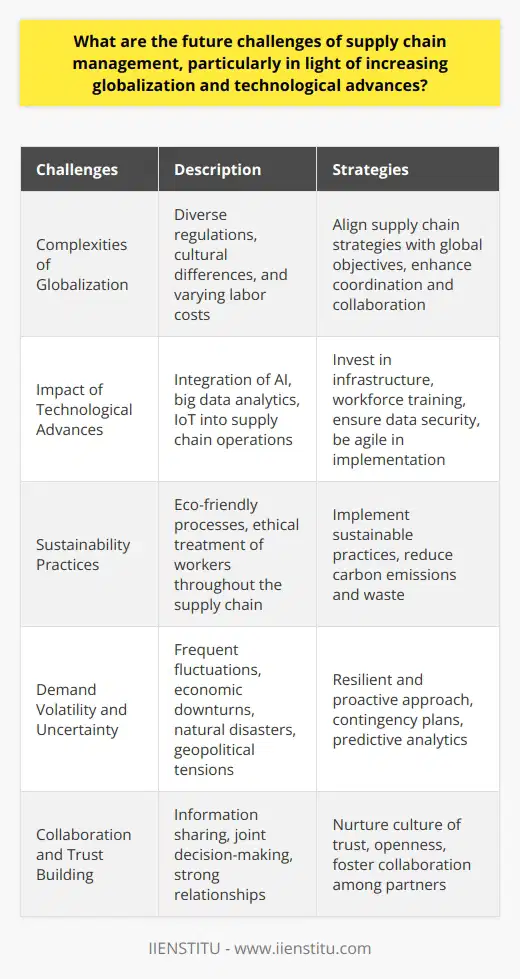
How do you effectively analyze a supply chain to identify areas for improvement and potential risks?
Identifying Improvement Opportunities
To effectively analyze a supply chain, it is essential to assess each component of the system thoroughly. This involves examining the entire process, from raw material acquisition to the delivery of the final product to the end-customer. A holistic view enables the identification of areas for improvement and potential risks that may hinder efficiency and overall performance.
Mapping the Supply Chain
The initial step in analyzing a supply chain is mapping the various stages comprising the system. This visual representation should include suppliers, manufacturers, distributors, retailers, and customers. Mapping provides a clear understanding of the network structure, thereby detecting any bottlenecks, redundancies, or weak links requiring attention.
Benchmarking Performance Metrics
It is crucial to measure the performance of each stage of the supply chain using relevant key performance indicators (KPIs). Comparing these metrics against industry benchmarks can help recognize areas where improvements can be achieved. High-performing supply chains often exhibit strong responsiveness, flexibility, and agility, and organizations should strive to attain these benchmarks.
Monitoring Supplier Relationships
A supply chain's effectiveness is heavily reliant on strong supplier relationships. Regularly monitoring and evaluating suppliers can ensure their performance aligns with the organization's requirements. Active engagement with suppliers enables early detection of potential risks, such as financial instability, production capacity limitations, or quality issues, thus paving the way for swift remedial action.
Adopting Risk Management Practices
A comprehensive risk management strategy is integral to maintain supply chain resilience. Organizations must evaluate their exposure to risk, considering factors such as natural disasters, geopolitical conflicts, or supplier bankruptcy. Implementing contingency plans and diversification strategies can mitigate vulnerabilities and prevent disruptions to the supply chain.
Leveraging Technology and Data
Finally, leveraging advanced technology and data analytics can significantly enhance supply chain analysis. Technologies such as the internet of things (IoT), artificial intelligence (AI), and blockchain offer real-time insights into supply chain activities. By harnessing data through these technologies, organizations can make data-driven decisions to optimize performance and anticipate potential risks.
In conclusion, an effective supply chain analysis involves mapping the system, benchmarking performance, monitoring supplier relationships, adopting risk management practices, and leveraging technology and data to identify areas for improvement and potential risks. By addressing these components, organizations can enhance their supply chain resilience, efficiency, and performance in the long run.
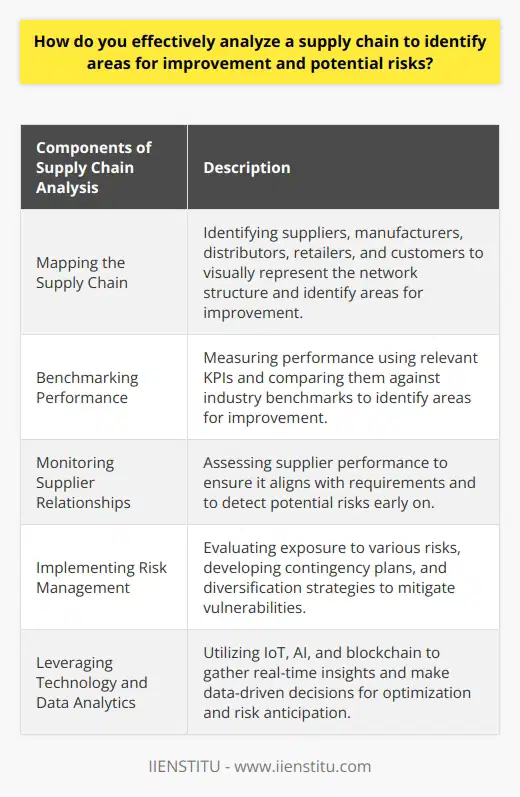
What is one of the major challenges in supply chain management, and how can organizations adapt to overcome this challenge?
Challenge: Demand Uncertainty
One major challenge in supply chain management is demand uncertainty, which is the difficulty in predicting the level of customer demand for products and services. This issue may arise from various factors such as rapid changes in customer preferences, economic fluctuations, and technological disruptions.
Adaptive Forecasting Techniques
To cope with demand uncertainty, organizations can adopt adaptive forecasting techniques that rely on real-time data and advanced methodologies to forecast customer demands accurately. These methods use current market trends, historical data, and predictive models to make data-driven decisions on inventory levels and production schedules, thereby reducing the risk of shortages or excess stock.
Collaborative Relationships with Suppliers
Engaging in collaborative relationships with suppliers can also help organizations deal with demand uncertainty. This collaboration might include sharing demand forecasts, inventory levels, and production schedules to create a more transparent and responsive supply chain. By working closely with suppliers, organizations enhance their ability to respond quickly to changing market conditions and ensure a continuous flow of products to customers.
Flexible Supply Chain Strategies
Developing flexible supply chain strategies is another approach to conquering the challenge of demand uncertainty. Organizations should invest in supply chain capabilities that enable them to quickly adjust their operations in response to fluctuations in customer demand. This flexibility could involve implementing multi-sourcing strategies, investing in agile production facilities, and offering a wider range of customization options to customers.
Technological Innovations
Leveraging technological innovations can also assist organizations in managing demand uncertainty. Advanced information systems, like artificial intelligence and machine learning algorithms, can analyze vast amounts of data to identify patterns and insights that may contribute to more accurate demand forecasting. Furthermore, integrating these technologies across the supply chain can enable real-time data sharing and collaboration among all stakeholders, resulting in a more agile and demand-driven supply chain system.
Conclusion
In navigating the challenge of demand uncertainty, organizations must adopt adaptive forecasting techniques, engage in collaborative relationships with suppliers, and develop flexible supply chain strategies. Additionally, incorporating technological innovations into the supply chain can also contribute to better management of demand uncertainty. By embracing these measures, organizations are well-positioned to achieve more accurate demand forecasting and establish a supply chain system that is resilient and responsive to changing market conditions.
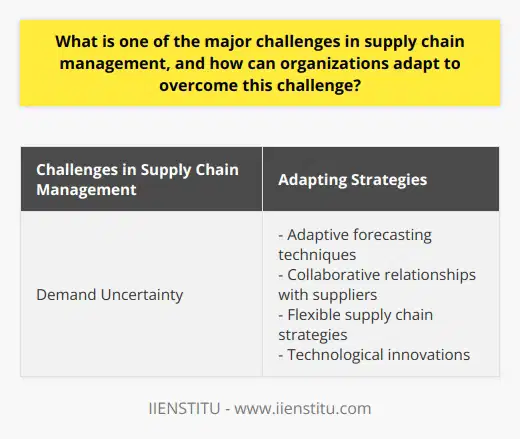
What are the benefits and challenges of supply chain management?
Benefits of Supply Chain Management
Improved Efficiency and Cost Reduction
Effective supply chain management facilitates operational efficiency and reduced costs by standardizing processes, utilizing economies of scale, and eliminating redundancies. It streamlines the flow of goods and information, resulting in improved responsiveness to customer needs and market shifts.
Enhanced Collaboration and Competitiveness
Supply chain management fosters collaboration among key stakeholders, including suppliers, manufacturers, distributors, and customers. This collaboration results in enhanced communication, better forecasting, and optimal decision-making. Ultimately, it increases an organization's competitiveness as they can respond promptly to changing consumer demands and global trends.
Increased Sustainability and Risk Mitigation
Another benefit is the ability to incorporate sustainable practices and mitigate risks. Supply chain management evaluates potential threats and implements preventative measures, such as diversified sourcing and inventory management strategies. Also, embracing environmentally-friendly approaches such as reducing waste and improving energy efficiency contribute to organizations' sustainable image and long-term viability.
Challenges of Supply Chain Management
Globalization and Complexity
With organizations functioning on a global scale, managing intricate supply chain networks is increasingly challenging. There are multiple layers of suppliers, channels, and geographies involved in the process, which can result in communication gaps, cultural barriers, and regulatory complexities that may hinder overall performance.
Technological Integration and Adaptability
Adopting and integrating technology into supply chain management can be difficult, particularly for small- and medium-sized enterprises. Technologies such as artificial intelligence, machine learning, and advanced analytics are rapidly evolving, requiring significant investments in infrastructure and employee training. Organizations must remain adaptable to ensure they continuously leverage the right technologies for their operations.
Risk Management and Uncertainty
Supply chains face numerous potential risks, including natural disasters, political instability, and economic fluctuations. The ongoing COVID-19 pandemic has further exemplified the need for rigorous risk management processes to identify and mitigate vulnerabilities. Organizations must dedicate resources to securing their supply chains and protecting their business continuity in the face of uncertainties.
In conclusion, supply chain management offers a plethora of benefits, such as increased efficiency, improved collaboration, and enhanced sustainability. However, it also presents challenges in terms of globalization, technological integration, and risk management. Organizations must find the right balance and adapt to these challenges to maximize the benefits offered by effective supply chain management.
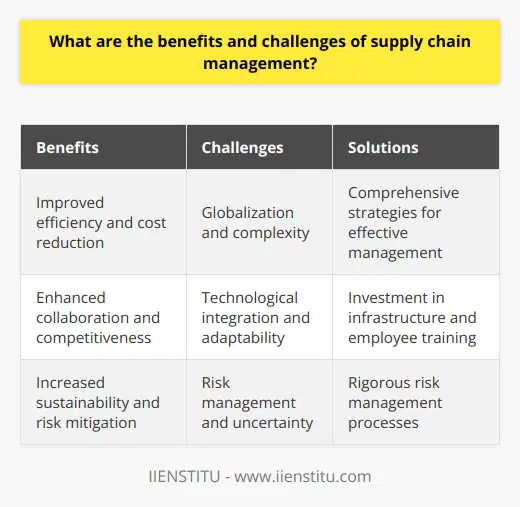
How do you analyze a supply chain to optimize efficiency and mitigate risks?
**Understanding the Supply Chain**
To analyze a supply chain for optimization and risk mitigation, it is crucial to understand the components and interdependencies among suppliers, manufacturers, distributors, and customers. This analysis facilitates the identification of bottlenecks, weak points, and potential risks in the supply chain.
**Process Mapping and Data Collection**
Process mapping is a useful technique for visually representing the steps of the supply chain. This allows for an overview of the processes, the interactions between components, and the flow of information, goods, and finances. Coupled with data collection on lead times, inventory levels, and other performance measurements, this approach provides a solid foundation for optimization and risk assessment.
**Analyzing Performance and Identifying Improvement Areas**
With a clear understanding of the current state of the supply chain and relevant data, the next step is to assess its performance based on key performance indicators (KPIs). This can include efficiency metrics, such as lead times, stock turnover rates, or fill rates. Additionally, risk indicators, like supplier reliance or geopolitical uncertainties, should also be considered in the analysis. By benchmarking against industry standards, areas for improvement or potential risks can be identified.
**Optimization Techniques**
Various techniques can be employed to optimize the supply chain. Examples include lean approaches, such as the Just-in-Time (JIT) method, which minimizes inventory levels and reduces lead times. Another avenue is utilizing technology, like automation and artificial intelligence (AI), to streamline processes and improve efficiency. Collaboration between supply chain partners, including information sharing and joint planning, can also lead to synergies and mutual benefits.
**Risk Mitigation Strategies**
To effectively address supply chain risks, appropriate mitigation strategies should be developed. These may include diversifying supplier sources to avoid over-reliance on a single provider or establishing strategic stockpiles to buffer against potential disruptions. Building flexibility into the supply chain, such as incorporating alternative modes of transportation, can also enhance resilience to unforeseen events.
**Continuous Improvement and Monitoring**
Lastly, optimizing a supply chain is an ongoing process that requires continuous improvement and monitoring. Regularly reviewing performance metrics, updating process maps, and reassessing potential risks will ensure that the supply chain remains efficient and resilient in the face of evolving challenges.
In summary, analyzing a supply chain to optimize efficiency and mitigate risks involves understanding the components and their interdependencies, process mapping and data collection, performance evaluation, and the implementation of optimization techniques and risk mitigation strategies. This systematic approach, combined with continuous improvement and monitoring, will result in a more efficient and resilient supply chain.
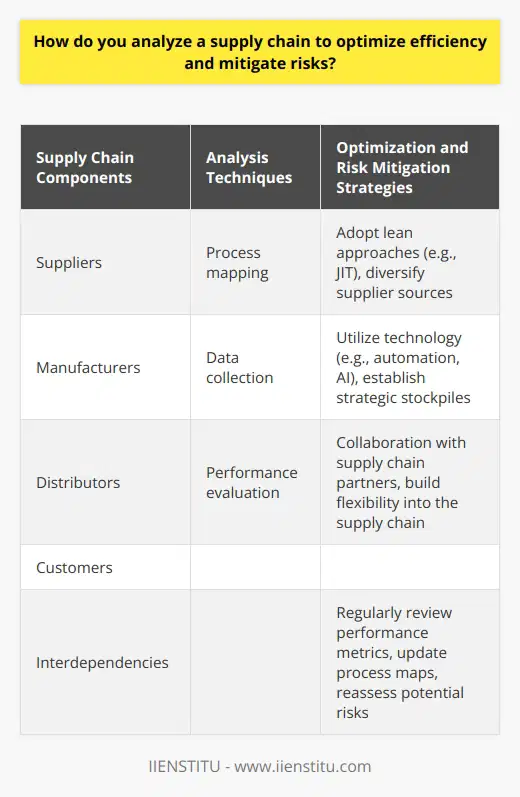
What are the implications of emerging technologies on the future of supply chain management and how can organizations adapt to these changes?
Implications of Emerging Technologies
Emerging technologies, such as Artificial Intelligence (AI), the Internet of Things (IoT), and blockchain, are revolutionizing supply chain management by increasing efficiency and transparency. With AI, organizations can optimize their supply chain processes by utilizing machine learning algorithms to predict demand patterns, automate inventory management, and enhance decision-making. IoT devices enable real-time tracking and monitoring of goods, increasing visibility and reducing operational costs. Blockchain technology promotes secure and transparent transactions and record-keeping, enabling trustworthy collaboration among supply chain stakeholders.
Adapting to Technological Changes
To adapt to these changes, organizations must invest in technological infrastructure and research to stay ahead of industry developments. This involves not only implementing the latest tools and systems but also investing in employee training and upskilling. By fostering a culture of continuous learning, organizations can ensure that their workforce is prepared to embrace and capitalize on new technological advancements.
Collaborating with Partners
Additionally, organizations should actively seek collaboration opportunities with other industry players to tap into their respective strengths and expertise. Collaborative partnerships can help accelerate innovation and facilitate seamless integration of emerging technologies across the supply chain. This not only boosts competitiveness but also aids in streamlining processes, reducing bottlenecks, and enhancing overall effectiveness.
Data-Driven Decision-Making
Embracing data-driven decision-making is essential in adapting to technological disruptions. By leveraging data analytics and insights, organizations can make more informed decisions that are backed by evidence and focused on delivering value to the end customer. Recognizing the importance of data will enable organizations to optimize their supply chain operations, eliminate inefficiencies, and drive sustainable growth.
Strategic Planning and Flexibility
Finally, organizations need to develop robust strategies to navigate the dynamic landscape created by emerging technologies. By adopting a proactive approach and fostering agility, organizations can pivot swiftly in response to new challenges and seize emerging opportunities as they arise. This will involve prioritizing investments in emerging technologies, redesigning processes to accommodate new tools, and establishing effective collaboration mechanisms to support innovation.
In conclusion, organizations can leverage the potential of emerging technologies to drive supply chain transformation by investing in technological infrastructure, promoting collaboration, embracing data-driven decision-making, and prioritizing strategic planning and flexibility. By doing so, they can ensure their continued success in a rapidly evolving global market.
